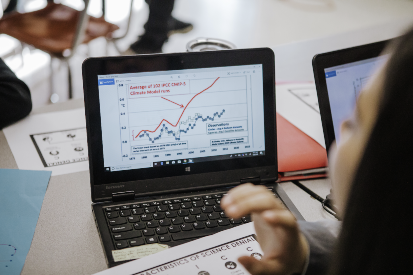NGSS
Disciplinary Core Ideas
- HS-ESS2.A1: Earth's systems, being dynamic and interacting, cause feedback effects that can increase or decrease the original changes.
- HS-ESS2.D1: The foundation for Earth's global climate systems is the electromagnetic radiation from the sun, as well as its reflection, absorption, storage, and redistribution among the atmosphere, ocean, and land systems, and this energy's re-radiation into space.
- HS-ESS2.D2: Gradual atmospheric changes were due to plants and other organisms that captured carbon dioxide and released oxygen.
- HS-ESS2.D3: Changes in the atmosphere due to human activity have increased carbon dioxide concentrations and thus affect climate.
- HS-ESS2.D4: Current models predict that, although future regional climate changes will be complex and varied, average global temperatures will continue to rise. The outcomes predicted by global climate models strongly depend on the amounts of human-generated greenhouse gases added to the atmosphere each year and by the ways in which these gases are absorbed by the ocean and biosphere.
- HS-ESS3.D1: Though the magnitudes of human impacts are greater than they have ever been, so too are human abilities to model, predict, and manage current and future impacts.
- HS-ESS3.D2: Through computer simulations and other studies, important discoveries are still being made about how the ocean, the atmosphere, and the biosphere interact and are modified in response to human activities.
Performance Expectations
- HS-ESS2-4: Use a model to describe how variations in the flow of energy into and out of Earth’s systems result in changes in climate.
- HS-ESS3-5: Analyze geoscience data and the results from global climate models to make an evidence-based forecast of the current rate of climate change.
- HS-ESS3-6: Use a computational representation to illustrate the relationship among Earth systems and how they are being modified due to human activity.
- HS-PS3-1: Create a computational model to calculate the change in the energy of one component in a system when the change in energy of the other component(s) and energy flows in and out of the system are known.
Other Relevant NGSS References:
- NGSS Appendix F (pdf): Science and Engineering Practices in the NGSS
- NGSS Appendix G (pdf): Crosscutting Concepts
- NGSS Appendix H (pdf): Understanding the Scientific Enterprise: The Nature of Science in the Next Generation Science Standards
- NGSS Appendix J (pdf): Science, Technology, Society and the Environment
This is a beta version of Lesson Set Two.

